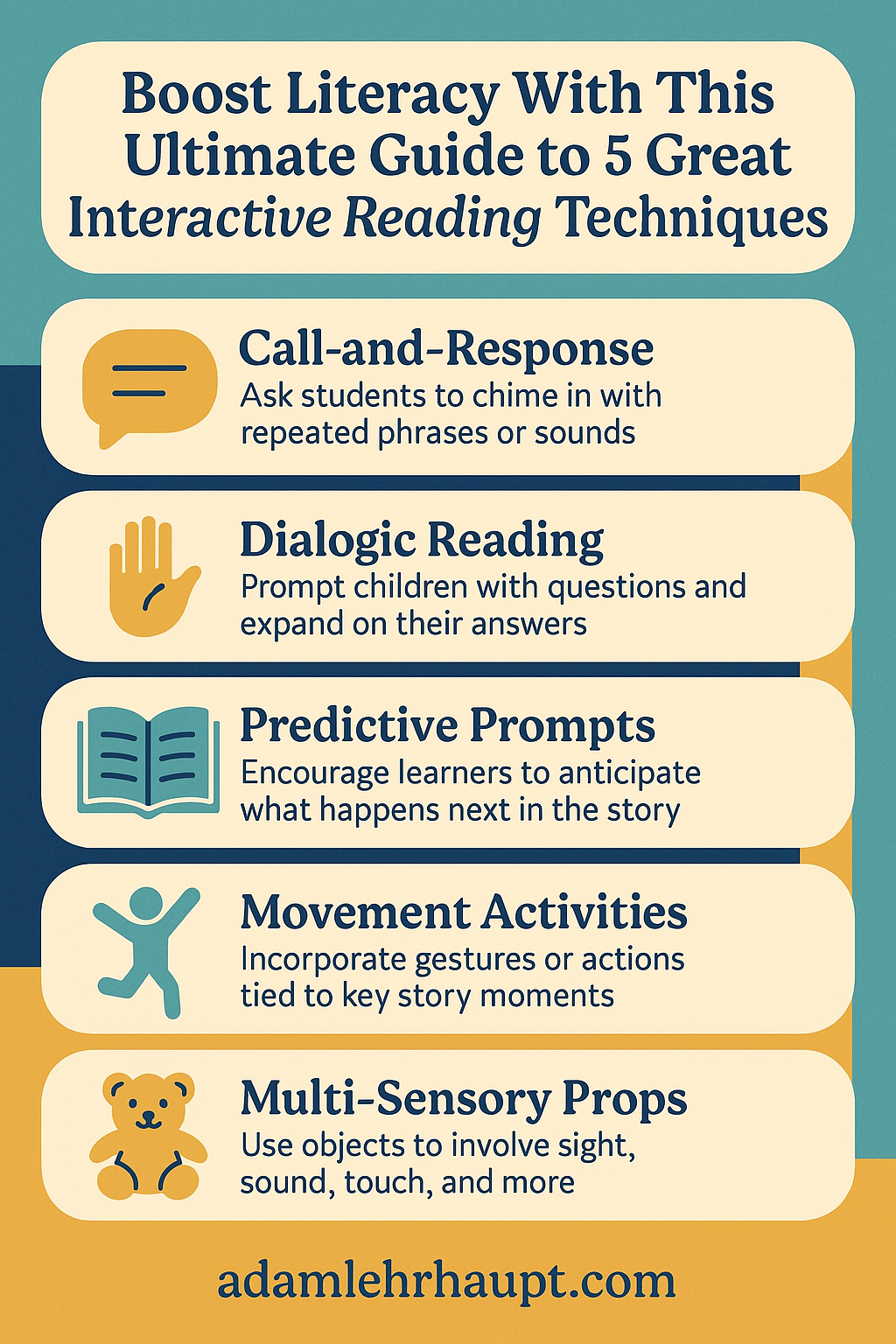The Science of Story
Ever wonder why some read-alouds completely captivate your class while others flop? The secret often lies in interactive reading techniques that invite students to move, respond, and connect on multiple levels. That’s no accident—it’s brain science in action. In this episode of Picture This, Adam and JaNay Brown‑Wood explore how techniques like rhythmic call‑and‑response, cultural storytelling traditions, and hands‑on activities turn picture‑book time into curriculum‑rich, empowering experiences.
Keep reading for some great ideas, or jump to the bottom and download the Interactive Reading Lesson Kit.
TL;DR
- Why it matters: Interactive reading techniques—not just passive read‑alouds—tap into brain alignment and emergent literacy to boost comprehension, motivation, and community.
- Top strategies: Call-and-response rhythm, dialogic prompts (CROWD/PEER), movement & multi‑sensory tools, fractured fairy‑tale retelling.
- Practical formats: Picture books like Jam 2, Imani’s Moon, We Are Lion Dancers, and Mahogany are perfect fits.
- Teacher tips: Small‑group scaffolding, informed reflection on who tells what story, easy differentiation.
- Bonus activities: STEM extensions, family reading nights, student‑created fractured tales worksheets.
Introduction
Librarians and classroom teachers, if you’ve ever wondered why these methods feel so powerful—or how to convince an admin or skeptical colleague—they’ll walk you through the research behind it, demo practical move‑in‑seconds tips, and show you how books like Scientists Like Me and On Our Way, What a Day align perfectly with cross‑curricular goals.
1. Why Interactive Reading Techniques Work: The Brain Science Behind the Magic
The Problem: Reading aloud can feel flat—your voice, static pages, disengaged listeners.
Why It Works: Rhythm matters. Cambridge researcher Professor Usha Goswami found that rhythmic stories line up brain waves between reader and listener, boosting attention and emotional connection during read‑alouds (Institute of Education Sciences).
- Picture Book Pairing: Jam, Too (onomatopoeic rhythm & call‑and‑response)
- Out‑of‑the‑Box Activity: Clap or stomp along with the rhythm; pause and encourage children to echo a beat phrase back.
- Curriculum Links: Language arts (phonemic awareness), music (beat/rhythm), social‑emotional (shared group experience).
- Real Talk: Takes practice—and space for movement! But it energizes your read‑aloud block.
- Pro Tip: Practice delivery beforehand—kids will feed off your confidence and timing.
2. Dialogic Reading: Where Questions Build Ownership
The Problem: Kids zone out when reading is passive. Stories go in one ear, out the other.
Why It Works: Dialogic reading—think CROWD prompts and the PEER model—turns reading into interaction. Studies show it improves comprehension, vocabulary, and reading motivation in early learners (Institute of Education Sciences, ResearchGate, Reach Out and Read).
- Picture Book Pairing: Imani’s Moon or any rich narrative text
- Out‑of‑the‑Box Activity: Pause mid‑story to ask open‑ended “wh‑” or recall questions. Invite kids to become the reader for a page.
- Curriculum Links: ELA comprehension standards, narrative structure, vocabulary development.
- Real Talk: Pacing slows—but kids remember more and ask better questions.
- Pro Tip: Model dialogic prompts for librarians and co‑teachers—they’re easier than they seem.
3. Embodied Cognition: Learning with Movement & Multi‑Sensory Engagement
The Problem: Literacy feels abstract. Not for embodied learners.
Why It Works: Embodied cognition research shows that action and language activate mirror neurons—so when kids move or mimic action words, comprehension gets ingrained deeper (Taylor & Francis Online, Institute of Education Sciences).
- Picture Book Pairing: Scientists Like Me (STEM‑infused with hands‑on prompts), Mahogany: A Little Red Riding Hood Tale (movement in storytelling), On Our Way, What a Day (incorporates jazz and movement)
- Out‑of‑the‑Box Activity: Ask students to perform an action word from a book (e.g., safari walk, scientist experiment gesture), or code a simple robot warrior to mimic a Maasai dance (as one class did with Imani’s Moon)
- Curriculum Links: Science & math (patterning, experiments), physical education, arts integration
- Real Talk: Requires props or tech support—start small with gesture prompts before fully launching robotics.
- Pro Tip: Invite paraprofessionals or volunteers to assist with movement-based stations.
4. Representation & Intentional Storytelling: Who Gets to Tell the Story?
The Problem: Libraries and classroom book collections often lack diversity—students don’t always see themselves in stories.
Why It Works: When children see themselves in culturally rich stories, their engagement skyrockets. Intentional representation also fosters identity development and empathy (Joint reading researcher Anat Ninio).
- Picture Book Pairing: Grandma’s Tiny House, Acacia, Imani’s Moon
- Out‑of‑the‑Box Activity: Compare fractured fairy‑tale versions—traditional vs. JaNay’s. Then ask students to create their own character-based versions, based on their backgrounds.
- Curriculum Links: Social studies (cultural traditions), language arts (oral storytelling), SEL (positive identity)
- Real Talk: Research and vet voices carefully—JaNay emphasizes authors sometimes need to collaborate or defer if it’s not their own story (interactive reading techniques research on Wikipedia).
- Pro Tip: Curate inclusive collections in consultation with librarians; use lists like We Need Diverse Books and librarian recommendations to fill gaps.
5. Cross‑Age Applications: Teaching Picture Books to Adults and Older Kids
The Problem: Many educators dismiss picture books as “just for little kids”—missing a whole toolset.
Why It Works: Picture books exemplify dialogic reading, storytelling arcs, emergent literacy principles—and even adults internalize them deeply when modeled (emergent literacies on Wikipedia, dialogic reading jumpstarts from Research Outreach).
- Picture Book Pairing: Bear Snores On, Jam 2, Scientists Like Me
- Out‑of‑the‑Box Activity: Use picture books in teacher professional learning sessions; librarians can model interactive read-aloud for older grades using CROWD/PEER prompts.
- Curriculum Links: Adult learning (developmental education), teacher training, library programming
- Real Talk: Adults might resist “childish books,” but watching professionals model makes a powerful shift.
- Pro Tip: Use “Jammies with JaNay” resources as story-start models to show teachers how simple it can be (dialogic reading intervention from Institute of Education Sciences).
Bonus Ideas for Busy Educators
- Family Reading Night Toolkit: Invite families to experience call‑and‑response and dialogic prompts; provide simple Q cards and ask them to respond.
- STEM‑Story Extension: After reading Scientists Like Me, let students interview a local scientist or video-chat them; integrate craft or coding activity.
- Fractured Fairy‑Tale Writing Prompt: Use Mahogany and Acacia as mentor texts. Have kids write and illustrate their own versions using personal or cultural influences.
- Visual Scavenger Hunts: Like hidden bees in Grandma’s Tiny House, add your own “seek and find” detail in art; great for observation and critical thinking.
- Movement Stations: Use key action words in books; kids rotate through stations where they act them out (e.g. “lift,” “jump,” “discover,” “spin”).
Frequently Asked Questions
What are the best interactive reading techniques for K–2 students?
For early elementary learners, interactive reading techniques like call-and-response, predictive questions, and movement-based prompts work especially well. They build engagement and foundational literacy skills through multisensory learning.
How long does dialogic reading take compared to a regular read‑aloud?
Dialogic reading adds only a few minutes—but that boosts comprehension, vocabulary, and even motivation (Check out this article on using dialogic reading techniques from Reach Out and Read).
Do I need special training to use CROWD or PEER prompts?
Nah—just start with one type (like open-ended “what do you see?”), then layer. Role‑playing with colleagues helps embed practice.
What if budget limits my ability to get diverse titles?
Partner with librarians, tap into free lists (like We Need Diverse Books), borrow from community libraries or seek grants/free book programs.
How can I differentiate for K–2 vs. Grades 3–5?
Use simpler picture books with more movement and choral repetition for younger kids. Older students can co-lead dialogic reading and write extensions.
How do I assess the effectiveness of interactive read‑alouds?
Use running records of student responses, measure vocabulary recall pre/post, and note improvements in listening and turn-taking behaviors.
Can these strategies be applied to multilingual learners?
Absolutely. Dialogic and multi‑sensory reading supports language learning, and call‑and‑response engages oral repetition—which helps build vocabulary and fluency.
How do I justify time for interactive read‑aloud when pacing is tight?
Research shows that despite a slight slowdown, comprehension, motivation, and emergent literacy skills improve significantly—and those pay dividends across domains (Dialogic Reading reports from The Institute of Education Sciences, journals.sagepub.com).
Conclusion
By adding interactive reading techniques like call-and-response and dialogic prompts, you’re not just filling time—you’re building comprehension, confidence, and connection that lasts.
Looking for even more interactive reading techniques to try in your next lesson? Check out FREE Interactive Reading Lesson Kit for read-aloud success.




